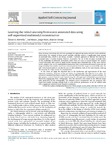Mostrar o rexistro simple do ítem
Learning the Retinal Anatomy From Scarce Annotated Data Using Self-Supervised Multimodal Reconstruction
| dc.contributor.author | Hervella, Álvaro S. | |
| dc.contributor.author | Rouco, J. | |
| dc.contributor.author | Novo Buján, Jorge | |
| dc.contributor.author | Ortega Hortas, Marcos | |
| dc.date.accessioned | 2020-04-17T14:23:02Z | |
| dc.date.available | 2020-04-17T14:23:02Z | |
| dc.date.issued | 2020-03-13 | |
| dc.identifier.citation | Álvaro S. Hervella, José Rouco, Jorge Novo, Marcos Ortega, Learning the retinal anatomy from scarce annotated data using self-supervised multimodal reconstruction, Applied Soft Computing, Volume 91, 2020, 106210, ISSN 1568-4946, https://doi.org/10.1016/j.asoc.2020.106210. | es_ES |
| dc.identifier.issn | 1568-4946 | |
| dc.identifier.issn | 1872-9681 | |
| dc.identifier.uri | http://hdl.handle.net/2183/25360 | |
| dc.description.abstract | [Abstract] Deep learning is becoming the reference paradigm for approaching many computer vision problems. Nevertheless, the training of deep neural networks typically requires a significantly large amount of annotated data, which is not always available. A proven approach to alleviate the scarcity of annotated data is transfer learning. However, in practice, the use of this technique typically relies on the availability of additional annotations, either from the same or natural domain. We propose a novel alternative that allows to apply transfer learning from unlabelled data of the same domain, which consists in the use of a multimodal reconstruction task. A neural network trained to generate one image modality from another must learn relevant patterns from the images to successfully solve the task. These learned patterns can then be used to solve additional tasks in the same domain, reducing the necessity of a large amount of annotated data. In this work, we apply the described idea to the localization and segmentation of the most important anatomical structures of the eye fundus in retinography. The objective is to reduce the amount of annotated data that is required to solve the different tasks using deep neural networks. For that purpose, a neural network is pre-trained using the self-supervised multimodal reconstruction of fluorescein angiography from retinography. Then, the network is fine-tuned on the different target tasks performed on the retinography. The obtained results demonstrate that the proposed self-supervised transfer learning strategy leads to state-of-the-art performance in all the studied tasks with a significant reduction of the required annotations. | es_ES |
| dc.description.sponsorship | This work is supported by Instituto de Salud Carlos III, Government of Spain, and the European Regional Development Fund (ERDF) of the European Union (EU) through the DTS18/00136 research project, and by Ministerio de Economía, Industria y Competitividad, Government of Spain, through the DPI2015-69948-R research project. The authors of this work also receive financial support from the ERDF and Xunta de Galicia (Spain) through Grupo de Referencia Competitiva, ref. ED431C 2016-047, and from the European Social Fund (ESF) of the EU and Xunta de Galicia (Spain) through the predoctoral grant contract ref. ED481A-2017/328. CITIC, Centro de Investigación de Galicia ref. ED431G 2019/01, receives financial support from Consellería de Educación, Universidade e Formación Profesional, Xunta de Galicia (Spain) , through the ERDF (80%) and Secretaría Xeral de Universidades (20%) | es_ES |
| dc.description.sponsorship | Xunta de Galicia; ED431C 2016-047 | es_ES |
| dc.description.sponsorship | Xunta de Galicia ; ED481A-2017/328 | es_ES |
| dc.description.sponsorship | Xunta de Galicia; ED431G 2019/01 | es_ES |
| dc.language.iso | eng | es_ES |
| dc.publisher | Elsevier BV | es_ES |
| dc.relation | info:eu-repo/grantAgreement/MICINN/Plan Estatal de Investigación Científica y Técnica y de Innovación 2017-2020/DTS18%2F00136/ES/Plataforma online para prevención y detección precoz de enfermedad vascular mediante análisis automatizado de información e imagen clínica | |
| dc.relation | info:eu-repo/grantAgreement/MINECO/Plan Estatal de Investigación Científica y Técnica y de Innovación 2013-2016/DPI2015-69948-R/ES/IDENTIFICACION Y CARACTERIZACION DEL EDEMA MACULAR DIABETICO MEDIANTE ANALISIS AUTOMATICO DE TOMOGRAFIAS DE COHERENCIA OPTICA Y TECNICAS DE APRENDIZAJE MAQUINA | |
| dc.relation.uri | https://doi.org/10.1016/j.asoc.2020.106210 | es_ES |
| dc.rights | Atribución-NoComercial-SinDerivadas 4.0 Internacional (CC BY-NC-ND 4.0) | es_ES |
| dc.rights.uri | https://creativecommons.org/licenses/by-nc-nd/4.0/ | |
| dc.subject | Deep learning | es_ES |
| dc.subject | Eye fundus | es_ES |
| dc.subject | Self-supervised learning | es_ES |
| dc.subject | Optic disc | es_ES |
| dc.subject | Blood vessels | es_ES |
| dc.subject | Fovea | es_ES |
| dc.subject | Medical imaging | es_ES |
| dc.subject | Transfer learning | es_ES |
| dc.title | Learning the Retinal Anatomy From Scarce Annotated Data Using Self-Supervised Multimodal Reconstruction | es_ES |
| dc.type | info:eu-repo/semantics/article | es_ES |
| dc.rights.access | info:eu-repo/semantics/openAccess | es_ES |
| UDC.journalTitle | Applied Soft Computing | es_ES |
| UDC.volume | 91 | es_ES |
| UDC.startPage | 106210 | es_ES |
| dc.identifier.doi | 10.1016/j.asoc.2020.106210 |
Ficheiros no ítem
Este ítem aparece na(s) seguinte(s) colección(s)
-
GI-VARPA - Artigos [79]






